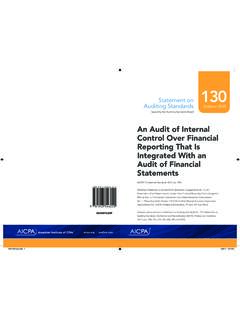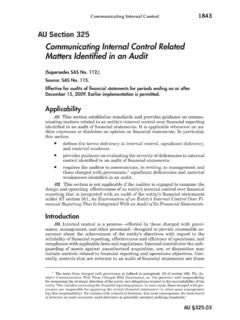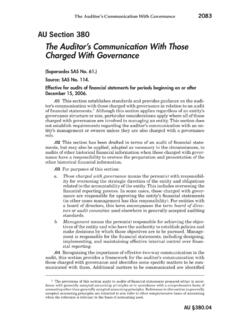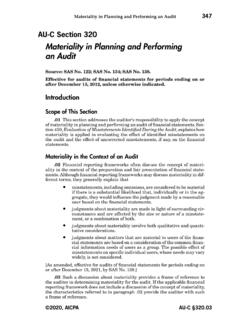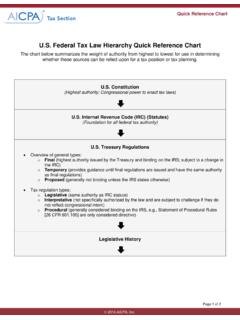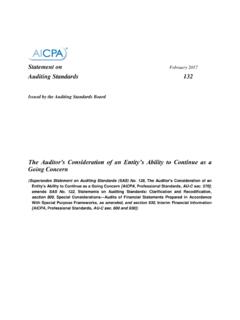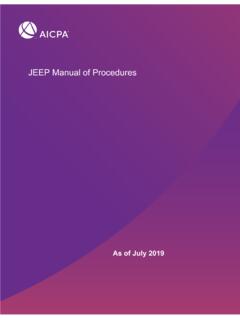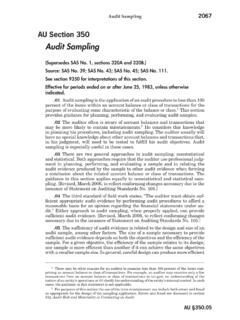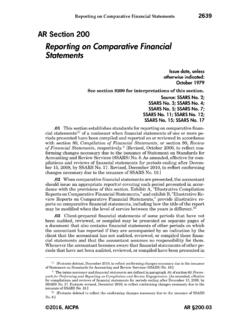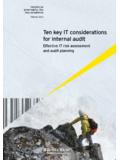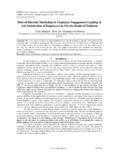Transcription of The Auditor’s Consideration of the Internal Audit Function ...
1 Auditor s Consideration of Internal Audit Function1805AU Section 322 The Auditor s Consideration of theInternal Audit Function in an Auditof Financial Statements(Supersedes SAS No. 9.)Source: SAS No. for audits of financial statements for periods ending after December15, 1991, unless otherwise auditor considers many factors in determining the nature, tim-ing, and extent of auditing procedures to be performed in an Audit of an entity'sfinancial statements. One of the factors is the existence of an Internal section provides the auditor with guidance on considering thework of Internal auditors and on using Internal auditors to provide direct as-sistance to the auditor in an Audit performed in accordance with generallyaccepted auditing of the Auditor and the Internal of the auditor's responsibilities in an Audit conducted in accor-dance with generally accepted auditing standards is to obtain sufficient ap-propriate Audit evidence to provide a reasonable basis for the opinion on theentity's financial statements.
2 In fulfilling this responsibility, the auditor main-tains independence from the entity. [Revised, March 2006, to reflect conform-ing changes necessary due to the issuance of Statement on Auditing StandardsNo. 105.] auditors are responsible for providing analyses, evaluations,assurances, recommendations, and other information to the entity's manage-ment and those charged with governance. To fulfill this responsibility, internalauditors maintain objectivity with respect to the activity being audited. [Re-vised, April 2007, to reflect conforming changes necessary due to the issuanceof Statement on Auditing Standards No. 114.]Obtaining an Understanding of the InternalAudit important responsibility of the Internal Audit Function is to moni-tor the performance of an entity's controls.
3 When obtaining an understanding of1 Aninternal Audit functionmay consist of one or more individuals who perform Internal auditingactivities within an entity. This section is not applicable to personnel who have the titleinternal auditorbut who do not perform Internal auditing activities as described Internal auditors are not independent from the entity, The Institute of Internal Au-ditors'Standards for the Professional Practice of Internal Auditingdefines Internal auditing as anindependent appraisal Function and requires Internal auditors to be independent of the activities theyaudit. This concept of independence is different from the independence the auditor maintains underthe AICPA Code of Professional Standards of Field Workinternal control,3the auditor should obtain an understanding of the internalaudit Function sufficient to identify those Internal Audit activities that are rel-evant to planning the Audit .
4 The extent of the procedures necessary to obtainthis understanding will vary, depending on the nature of those auditor ordinarily should make inquiries of appropriate manage-ment and Internal Audit personnel about the Internal auditors' status within the of professional standards (see paragraph .11). plan, including the nature, timing, and extent of Audit to records and whether there are limitations on the scope oftheir addition, the auditor might inquire about the Internal Audit Function 's char-ter, mission statement, or similar directive from management or those chargedwith governance. This inquiry will normally provide information about the goalsand objectives established for the Internal Audit Function .
5 [Revised, April 2007,to reflect conforming changes necessary due to the issuance of Statement onAuditing Standards No. 114.].06 Certain Internal Audit activities may not be relevant to an Audit of theentity's financial statements. For example, the Internal auditors' procedures toevaluate the efficiency of certain management decision-making processes areordinarily not relevant to a financial statement activities are those that provide evidence about the designand effectiveness of controls that pertain to the entity's ability to initiate, au-thorize, record, process, and report financial data consistent with the assertionsembodied in the financial statements or that provide direct evidence about po-tential misstatements of such data.
6 The auditor may find the results of the fol-lowing procedures helpful in assessing the relevancy of Internal Audit knowledge from prior-year how the Internal auditors allocate their Audit resourcesto financial or operating areas in response to their Internal Audit reports to obtain detailed information aboutthe scope of Internal Audit activities[Revised, April 2002, to reflect conforming changes necessary due to the is-suance of Statement on Auditing Standards No. 94. Revised, March 2006, toreflect conforming changes necessary due to the issuance of Statement on Au-diting Standards No. 106.].08If, after obtaining an understanding of the Internal Audit Function ,the auditor concludes that the Internal auditors' activities are not relevant tothe financial statement Audit , the auditor does not have to give further consid-eration to the Internal Audit Function unless the auditor requests direct assis-tance from the Internal auditors as described in paragraph.
7 27. Even if someof the Internal auditors' activities are relevant to the Audit , the auditor mayconclude that it would not be efficient to consider further the work of the in-ternal auditors. If the auditor decides that it would be efficient to consider howthe Internal auditors' work might affect the nature, timing, and extent of audit3 Section 314,Understanding the Entity and Its Environment and Assessing the Risks of MaterialMisstatement, describes the procedures the auditor follows to obtain an understanding of internalcontrol and indicates that the Internal Audit Function is part of the entity's monitoring component.[Footnote revised, March 2006, to reflect conforming changes necessary due to the issuance of State-ment on Auditing Standards No.]
8 109.]AU s Consideration of Internal Audit Function1807procedures, the auditor should assess the competence and objectivity of the in-ternal Audit Function in light of the intended effect of the Internal auditors' workon the the Competence and Objectivity of theInternal AuditorsCompetence of the Internal assessing the Internal auditors' competence, the auditor shouldobtain or update information from prior years about such factors as Educational level and professional experience of Internal auditors. Professional certification and continuing education. Audit policies, programs, and procedures. Practices regarding assignment of Internal auditors. Supervision and review of Internal auditors' activities.
9 Quality of working-paper documentation, reports, and recommendations. Evaluation of Internal auditors' of the Internal assessing the Internal auditors' objectivity, the auditor shouldobtain or update information from prior years about such factors as The organizational status of the Internal auditor responsible for theinternal Audit Function , including Whether the Internal auditor reports to an officer of sufficient sta-tus to ensure broad Audit coverage and adequate Consideration of,and action on, the findings and recommendations of the internalauditors. Whether the Internal auditor has direct access and reports regularlyto those charged with governance.
10 Whether those charged with governance oversee employment deci-sions related to the Internal auditor. Policies to maintain Internal auditors' objectivity about the areasaudited, including Policies prohibiting Internal auditors from auditing areas where rel-atives are employed in important or Audit -sensitive positions. Policies prohibiting Internal auditors from auditing areas wherethey were recently assigned or are scheduled to be assigned on com-pletion of responsibilities in the Internal Audit Function .[Revised, April 2007, to reflect conforming changes necessary due to the is-suance of Statement on Auditing Standards No. 114.]
